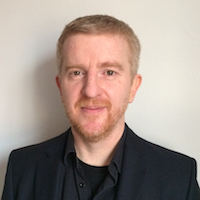- J. Elmsley, A., Armstrong, N. and Weyde, T. (2017). Generating Time: Rhythmic Perception, Prediction and Production with Recurrent Neural Networks. Journal of Creative Music Systems, 1(2). doi:10.5920/jcms.2017.04.
- Armstrong, N. (2014). Bold Tendencies. TEMPO, 68(267), pp. 63–65. doi:10.1017/S0040298213001393.
Contact details
Address
Northampton Square
London EC1V 0HB
United Kingdom
About
Overview
Professor Newton Armstrong is a composer, performer, and occasional builder of electronic musical instruments. His work has encompassed a wide range of activities, including score-based instrumental music, projects for children, and improvisation projects with dancers, choreographers, film, video, and installation artists. Much of his music is situated across and between the areas of instrumental and electronic music, with focus directed towards the composed interactions between people, technologies, and their environments.
Armstrong has been the recipient of grants and commissions from the Andrew W. Mellon Foundation, the Australia Council for the Arts, the Australian Network for Art and Technology, the Ian Potter Foundation, Arts Victoria, ELISION, LIBRA, and the Merce Cunningham Dance Company. His music has been featured at festivals such as Darmstadt, Festival d'Automne à Paris, Festival of Exiles (Berlin), What is Music? (Melbourne), Movement Research Festival (New York), Grønland Kammermusikkfestival (Oslo), Images Sonores (Liège), Ars Musica (Brussels), Unerhörte Musik (Berlin), and Music at Villa Romana (Florence).
After completing a PhD at Princeton University (2001-6), he taught in the Music Department and Graduate Program in Electroacoustic Music at Dartmouth College, USA (2006-8). He joined City University London as University Research Fellow in 2009, and was appointed Lecturer in Composition in 2011.
Qualifications
- Ph.D., Princeton University, United States, 2006
- M.F.A., Princeton University, United States, 2003
- M.Mus., University of Melbourne, Australia, 1996
- B.Mus. (Hons), University of Melbourne, Australia, 1991
Research
Research interests
Instrumental and Electronic Composition
Electronic and Digital Performance
Sound Art
Acoustics, Psychoacoustics, and Phenonenologies of Listening
Software and Hardware Design and Development
Aesthetics of 20th and 21st Century Experimental Music
Publications
Publications by category
Book
- Armstrong, N. (2007). An Enactive Approach to Digital Musical Instrument Design. VDM Verlag Dr. Mueller e.K.. ISBN 978-3-8364-1926-0.
Chapters (2)
- Hall, T., Armstrong, N. and Hoadley, R. (2023). Notations and Score-making. The SuperCollider Book Cambridge, MA: MIT Press.
- Lambert, A., Weyde, T.E. and Armstrong, N. (2014). Beyond the Beat: Towards Metre, Rhythm and Melody Modelling with Hybrid Oscillator Networks. In Georgaki, A. and Kouroupetroglou, G. (Eds.), Music Technology Meets Philosophy: from Digital Echos to Virtual Ethos (pp. 485–490). International Computer Music Association: San Francisco. ISBN 978-0-9845274-3-4.
Compositions (14)
- Armstrong, N. (2022). The Book of the Sediments.
- Armstrong, N. (2019). A line alongside itself. (Solo cello, with four pre-recorded cellos, and electronic sounds)
- Armstrong, N. (2019). Two Canons for Kathryn.
- Armstrong, N. (2018). thread—surface. (Bass clarinet in Bb, electric guitar (6 string), piano, violin, violoncello, electronic sounds)
- Armstrong, N. (2016). The way to go out. (Violin, violoncello, vibraphone, piano, and electronic sounds)
- Armstrong, N. (2016). Partial objects. (Three women's voices and electronic sounds)
- Armstrong, N. (2015). Modes of forgetting. (Two pianos and electronics)
- Armstrong, N. (2013). Nature pieces. (Clarinet, guitar, piano, violin, viola, violoncello, and electronic sounds)
- Armstrong, N. (2012). making one leaf transparent and then another. (Piano and electronic sounds)
- Armstrong, N. (2011). Too slow, for Milton. (Piano)
- Armstrong, N. (2010). unsaying. (Voice and violoncello)
- Armstrong, N. (2010). Study in tiled light. (Two pianos)
- Armstrong, N. (2010). Three Windows. (Piano and live electronics)
- Armstrong, N., Chavez, M., Linton, D. and Moore, S. (2008). Beacon Event.
Conference papers and proceedings (5)
- Lambert, A.J., Weyde, T. and Armstrong, N. (2016). Adaptive frequency neural networks for dynamic pulse and metre perception.
- Armstrong, N. (2015). Listening as a material. 27 March, Conservatoire Royal de Mons - Ecole Supérieure des Arts.
- Lambert, A.J., Weyde, T. and Armstrong, N. (2015). Perceiving and predicting expressive rhythm with recurrent neural networks.
- Lambert, A., Weyde, T. and Armstrong, N. (2014). Beyond the beat: Towards metre, rhythm and melody modelling with hybrid oscillator networks.
- Lambert, A., Weyde, T. and Armstrong, N. (2014). Studying the effect of metre perception on rhythm and melody modelling with LSTMs.
Internet publications (2)
- Armstrong, N. (2013). Stockhausen's MANTRA (1970): A Technical Guide.
- Armstrong, N. (2008). A Too Brief Introduction to the New York School.
Journal articles (2)
Media
- Armstrong, N. (2020). The way to go out.
Software
- Armstrong, N. (2023). Fosc v0.9.0. GitHub.
Other (2)
- Armstrong, N. (2019). The in-between of line and surface: A line alongside itself.
- Knoop, M., Chadwick, R. and Armstrong, N. (2015). Karlheinz Stockhausen: Mantra.
